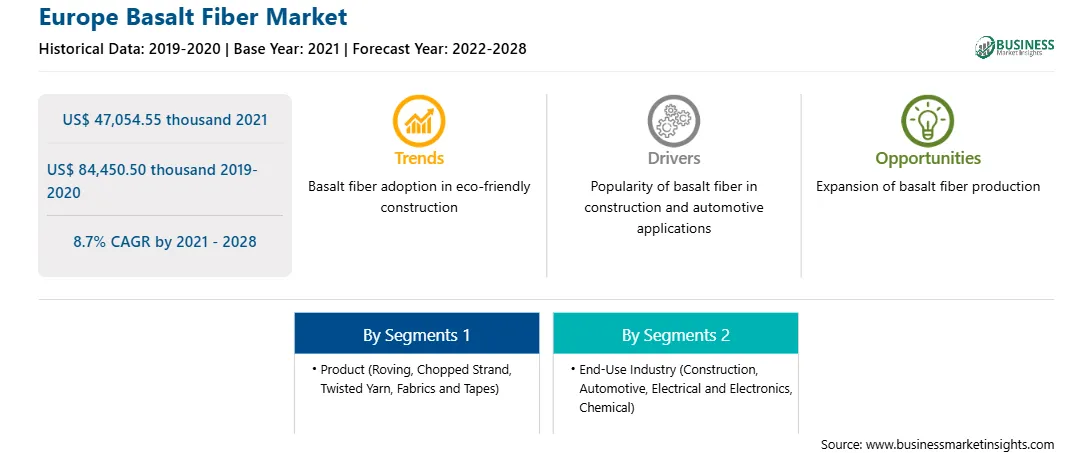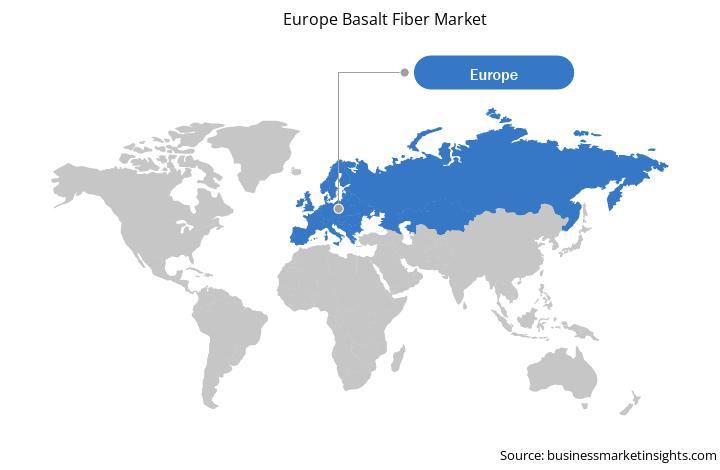Europe comprises several economies such as Germany, Russia, France, the UK, and Italy. The rising investments in the construction industry along with increasing growth in the automotive industry are driving the growth of the basalt fiber market in Europe. More than 70% of the EU’s total investment in the construction of buildings and other structures was invested by 5 countries alone, which are Germany, France, the UK, Italy, and Spain. 51% of the EU’s investment is in the residential sector and the remaining is used for the construction of nonresidential buildings and structures. In the construction industry, basalt fibers are used in the production of reinforced bars, for external reinforcement in housing and infrastructure, and for producing reinforced mesh that are designed for reinforcing road and highway overlays. Thus, a rising construction industry would provide lucrative opportunities for the basalt fiber market to grow in Europe during the forecast period. Europe is one of the regions that contribute to the largest production and consumption of basalt fiber. Along with this, there are several composite part fabricators in Russia and Ukraine using basalt composites and serving various industries. The region has witnessed a growing demand for basalt fibers from the automotive industry as stringent regulations are prevailing in the EU regarding vehicle emissions and greenhouse gas amongst others. According to the European Automobile Manufacturers’ Association, or ACEA, the EU commercial vehicle output grew by 2.6% and reached 2.8 million units in 2018. In addition, there have been various research and development projects focusing on the usage of basalt fiber in the automotive industry. EIT Raw Materials, the European raw materials association, allocated €1,317 million to finance the research project C2CC (Cradle-to-Cradle Composites), which is carried out to develop innovative composite materials based on basalt fiber and bio-resin for the automotive industry. Thus, the rising construction and automotive industries along with the increasing research and development would fuel the growth of the basalt fiber market in Europe during the forecast period.
In Europe, France, the UK, and Russia are the worst-impacted countries by the pandemic. The region is estimated to suffer an economic hit due to the lack of revenue from various industries subjected to disruption in the supply chain. As of August 31, 2021, the total number of confirmed cases in Europe is 65,138,274. The massive outbreak of the pandemic has created a temporary distortion in operation efficiencies of industrial bases in the European market. The basalt fiber market has been negatively impacted due to limited operational capabilities due to COVID-19 restrictions. However, the rising demand for basalt fiber across diverse industrial applications is expected to substantially promote the demand for basalt fiber.

Strategic insights for the Europe Basalt Fiber provides data-driven analysis of the industry landscape, including current trends, key players, and regional nuances. These insights offer actionable recommendations, enabling readers to differentiate themselves from competitors by identifying untapped segments or developing unique value propositions. Leveraging data analytics, these insights help industry players anticipate the market shifts, whether investors, manufacturers, or other stakeholders. A future-oriented perspective is essential, helping stakeholders anticipate market shifts and position themselves for long-term success in this dynamic region. Ultimately, effective strategic insights empower readers to make informed decisions that drive profitability and achieve their business objectives within the market.

| Report Attribute | Details |
|---|---|
| Market size in 2021 | US$ 47,054.55 thousand |
| Market Size by 2028 | US$ 84,450.50 thousand |
| CAGR (2021 - 2028) | 8.7% |
| Historical Data | 2019-2020 |
| Forecast period | 2022-2028 |
| Segments Covered |
By Product
|
| Regions and Countries Covered | Europe
|
| Market leaders and key company profiles |
|
The geographic scope of the Europe Basalt Fiber refers to the specific areas in which a business operates and competes. Understanding local distinctions, such as diverse consumer preferences (e.g., demand for specific plug types or battery backup durations), varying economic conditions, and regulatory environments, is crucial for tailoring strategies to specific markets. Businesses can expand their reach by identifying underserved areas or adapting their offerings to meet local demands. A clear market focus allows for more effective resource allocation, targeted marketing campaigns, and better positioning against local competitors, ultimately driving growth in those targeted areas.

The Europe basalt fiber market is expected to grow from US$ 47,054.55 thousand in 2021 to US$ 84,450.50 thousand by 2028; it is estimated to grow at a CAGR of 8.7% from 2021 to 2028. Growing environmental awareness around the region has prompted a paradigm shift towards designing environmentally friendly materials. Basalt fibers are 100% natural. Basalt fiber can be categorized as a sustainable material because it is made of natural materials. Basalt rock is an ecological clean raw material used for the production of basalt fibers. The technology for the production of basalt fiber is not hazardous for the environment. No chemical additives, solvents, pigments, or other hazardous materials are used in its manufacturing. Basalt fiber is known as green industrial material. Basalt fiber is a non-polluting, green, environmentally friendly fiber product. It presents no hazard to health and environment. Also, the basalt ?bers are easy to recycle. The increasing demand for easily recyclable fibers such as basalt fiber will contribute to the expansion of the market. The products has no toxic reaction with air or water. They cause no chemical reactions that could harm human health or the environment when they come in contact with other chemicals. Thus, the environmentally friendly and easily recyclable nature of basalt fibers will provide more opportunities for the growth of the Europe market in coming years.
In terms of product, the fabrics and tapes segment accounted for the largest share of the Europe basalt fiber market in 2020. In terms of end-use industry, the automotive segment held a larger market share of the Europe basalt fiber market in 2020.
A few major primary and secondary sources referred to for preparing this report on the Europe basalt fiber market are company websites, annual reports, financial reports, national government documents, and statistical database, among others. Major companies listed in the report are Bastech Trade Ltd; Deutsche Basalt Faser Gmbh; Fiberbas Construction and Building Technologies; Hg Gbf Basalt Fiber Co., Ltd; Kamenny Vek Company; Mafic SA; and Technobasalt-Invest LLC.
The Europe Basalt Fiber Market is valued at US$ 47,054.55 thousand in 2021, it is projected to reach US$ 84,450.50 thousand by 2028.
As per our report Europe Basalt Fiber Market, the market size is valued at US$ 47,054.55 thousand in 2021, projecting it to reach US$ 84,450.50 thousand by 2028. This translates to a CAGR of approximately 8.7% during the forecast period.
The Europe Basalt Fiber Market report typically cover these key segments-
The historic period, base year, and forecast period can vary slightly depending on the specific market research report. However, for the Europe Basalt Fiber Market report:
The Europe Basalt Fiber Market is populated by several key players, each contributing to its growth and innovation. Some of the major players include:
The Europe Basalt Fiber Market report is valuable for diverse stakeholders, including:
Essentially, anyone involved in or considering involvement in the Europe Basalt Fiber Market value chain can benefit from the information contained in a comprehensive market report.